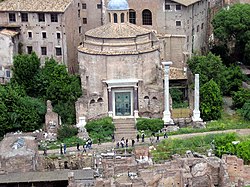A request that this article title be changed to List of churches in Rome is under discussion . Please do not move this article until the discussion is closed. |
This article needs additional citations for verification .(March 2016) |

There are more than 930 churches in Rome , [1] which makes it the city with the largest number of churches in the world. [2] Almost all of these are Catholic.
Contents
- Tituli
- "Seven Pilgrim Churches of Rome"
- Notable churches by construction time
- 4th century
- 5th century
- 6th century
- 7th century
- 8th century
- 9th century
- 10th century
- 11th century
- 12th century
- 13th century
- 14th century
- 15th century
- 16th century
- 17th century
- 18th century
- 19th century
- 20th century
- 21st century
- See also
- References
- Sources
- External links
When including the churches that have been deconsecrated or otherwise transformed, the total figure rises to about 1,500 churches. [3]
The first churches of Rome originated in places where Christians met. They were divided into three main categories: [4]
- the houses of private Roman citizens (people who hosted the meetings of Christians – also known as oratoria, oracula)
- the deaconries (places where charity distributions were given to the poor and placed under the control of a deacon; the greatest deaconries had many deacons, and one of them was elected[ citation needed ] archdeacon)
- other houses holding a titulus (known as domus ecclesia)













